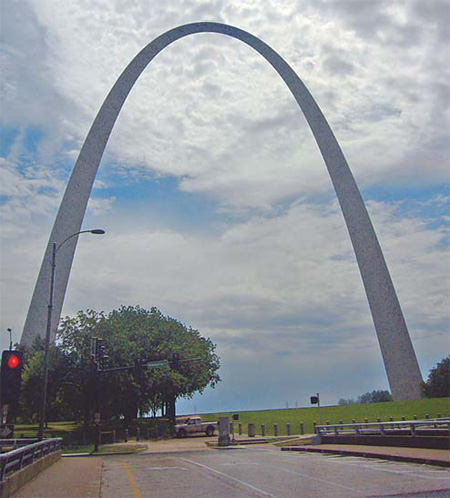Pioneers' CITY
|
The landmark Gateway Arch records an unforgettable piece of St. Louis' history. |
St. Louis and its famous Arch represent much of US' past and its present. Harvard graduate Judith Huang visits this iconic landmark and experiences the history.
S t. Louis, Missouri - founded in 1764 by two Frenchmen who named it for their king, Louis IX - is a city in the middle of things. It's at the confluence of the Missouri and the Mississippi, two great rivers that mark the width and breadth of North America. It's at the crossroads of North and South and halfway between the East Coast and the West. Sold by Napoleon to the Americans as part of the Louisiana Purchase in 1803, it sounded like a grand destination.
My friend Darell was working with an urban planning office. An idealistic student at Yale from Malaysia, she had hoped to do her bit this summer to revitalize the city. When I got out at the bus station, Darell was there.
"I'm so glad you're here," she said.
Soon we were whizzing on the subway to Washington University, where she was living. It was clean and empty.
"Not many people take the subway," she said. "Most people don't really leave their part of the city. The richer people have cars and the others don't have that much reason to come into town."
"Is it segregated?" I asked, noting that most of the faces around us were black.
"Oh yes," said Darell. "St. Louis is one of the most segregated cities in the US - there is an entrenched elite that lives in an established neighborhood, there are the young urban professionals, and then, I guess, there's everyone else."
This being just on the border of the South I knew without being told that by "elite" she meant white and by "everyone else" she meant poor and black.
"What do people make of you?"
"Well, people don't really see many Asians around here," she said. "So I guess they just treat me as normal. It's alright, I guess, but it's sort of obvious that I'm not from around here."
Much of the inner city of St. Louis fell victim to "white flight" in the 1950s, in which middle-class whites moved into the suburbs, even as black migration from the South became entrenched.
The city's decline began when river transportation became less important than railways, and then highways. Over time corporate pillars of the city relocated in a debilitating brain drain.
The city's landmark Gateway Arch is a fitting metaphor since St. Louis played a pivotal role in the westward expansion of white settlers in the 1800s.
It was from here that Thomas Jefferson sent Meriwether Lewis and William Clark on their exploration and it was in their westward footsteps that a whole generation of explorers, settlers and adventurers followed.
The Gateway Arch is a bright, silver, towering structure. It appears at first as if it were two-dimensional, like some child's sketch across a flattened sky. But as you get closer, its cunning architecture reveals itself: its two "feet" are equilateral triangles, creating the illusion of flatness from afar.
It looks like something aliens may have planted. At a height of 192 m, it is the tallest monument in the United States. Made of sheaths of stainless steel around a core of reinforced concrete and carbon steel, the structure itself is hollow, allowing visitors to rise to the top on an exhilarating elevator ride.
Underneath the arch, a dimly lit, lovingly-curated museum documents the journeys of those who left St. Louis for the west. It strikes a sad tone. Along one wall hang "peace medals" that American presidents awarded to Native American chiefs to declare the end of one war or another, even as settlers continued battling Native Americans across the west.
I stand under the arch, staring at the "Big Muddy", the Mississippi River - the heart and soul of North America, carrying vast amounts of soil and laden with the weight of so much history: of human enterprise and human misery, of commerce, migration and slavery.
A crowd of exuberant men emerges from under the arch - a mass of multicolored humanity from California with forearms covered in tattoos, faces red from the sun. But the surprising thing is their diversity - white, black, Hispanic, Asian.
There is a Vietnamese man among them who is excited to see me - he tells me he left Southeast Asia in the 1980s and hasn't been back since.
Before I leave, Darell insists she take me to the Central West End.
It's a hip new neighborhood - buskers warble at us on the streets, rainbow flags hang from the cafes. We share a pistachio ice cream and some excellent dark coffee. As we stroll along the streets I think about the arch again.
To me, the arch is about infinity - that yearning to encompass the globe. It is so much like a rainbow which lends color and brightness to the sky, but keeps people continually searching with the elusive promise of something better, the pot of gold, at the other end.
(China Daily 09/19/2010 page16)















